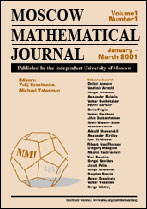|
This article is cited in 1 scientific paper (total in 1 paper)
On density of horospheres in dynamical laminations
A. Glutsyukab
a Poncelet Laboratory (UMI of CNRS and Independent University of Moscow), Moscow, Russia
b CNRS, Unité de Mathématiques Pures et Appliquées, M.R., École Normale Supérieure
de Lyon, Lyon, France
Abstract:
Sullivan's dictionary relates two domains of complex dynamics: Kleinian groups and rational iterations on the Riemann sphere. In 1997 M. Lyubich and Y. Minsky have extended the Sullivan's dictionary by constructing an analogue of the hyperbolic manifold of a Kleinian group: the so-called quotient hyperbolic lamination associated to a rational function. This is an abstract topological space constructed from the space of backward orbits of the rational function that carries a “foliation” (more precisely, lamination) by hyperbolic 3-manifolds (that may be singular). The hyperbolic leaves are dense, may be after deleting at most finite number of isolated leaves. Each hyperbolic leaf is foliated by horospheres, which form the unstable foliation (horospheric lamination) for the leafwise vertical geodesic flow. We consider the total laminated space with isolated hyperbolic leaves deleted. We prove that the horospheric lamination is topologically transitive (and there are a lot of dense horospheres), if and only if the corresponding rational function does not belong to the following list of exceptions: powers, Chebyshev polynomials, Lattès examples. We show that the horospheric lamination is minimal, if the corresponding function does not belong to the same list of exceptions and is critically nonrecurrent without parabolics.
Key words and phrases:
rational function, natural extension, repelling periodic orbit, affine lamination, hyperbolic lamination, horosphere, minimality.
Received: November 9, 2009; in revised form April 21, 2010
Citation:
A. Glutsyuk, “On density of horospheres in dynamical laminations”, Mosc. Math. J., 10:3 (2010), 547–591
Linking options:
https://www.mathnet.ru/eng/mmj392 https://www.mathnet.ru/eng/mmj/v10/i3/p547
|

| Statistics & downloads: |
| Abstract page: | 199 | | References: | 65 |
|




 Contact us:
Contact us: Terms of Use
Terms of Use
 Registration to the website
Registration to the website Logotypes
Logotypes








 Citation in format
Citation in format 
